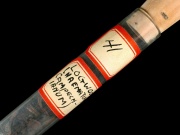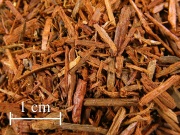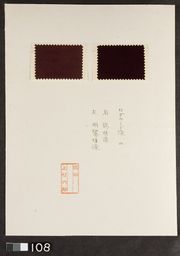Logwood
Description
A natural red dye extracted from a small redwood tree, Haematoxylon campechianum, indigenous to Central America, Mexico and the West Indies. The dye is contained in the heartwood of the tree; the wood is cut into blocks and sold directly or further cut into chips. Occasionally the wood pieces were used in marquetry. The primary water-soluble colorant, Hematoxylin, oxidizes to form the reddish-brown metallic crystals of hematein that are insoluble in water. Using a variety of mordants, the red extract can be prepared as a lake ranging in color from dark blue (Chromium or Copper), violet-blue (Alum or Tin) to black (Iron). Logwood was used in black inks (Iron gall ink and bichromate ink) and watercolors. It is still used as a black dye for textiles and Leather. Logwood dye was introduced in Europe by the Spainards in the 16th century. Because of poor lightfastness, Britain banned the use of logwood from 1581 and 1662. The ban was lifted about 100 years later when it was shown that mordents could make the color more stable. Logwood became an important dye because it was inexpensive and covered a wide color range. It is not used as an artist pigment because of poor lightfastness.
- See also [Uemera Dye Archive (Logwood)]
Synonyms and Related Terms
campeachy wood (Haematoxylon campechianum); Natural Black 1; CI 75290; bois de Campêche (Fr.); Blauholz (Deut.); campeche (Esp., Port.); aimatoxylo (Gr.); campeggio (It.); blauwhout (Ned.); campeachy lake; hematein; hematin; haematein; haematin; hematoxylin (colorless colorant in wood extract); hematoxylon (wood chips); haematoxlin; haematoxylon; haematoxylum; blockwood; St. Martin's wood; province wood
Other Properties
Haematoxylin is soluble in water. Haematein is insoluble in water or alcohol.
Haematein turns blue-violet with alkalis and deep red with acids (irreversible).
| Composition | C10H14O6-3H2O (dye) |
|---|---|
| CAS | 8005-33-2 |
| Density | 57-65 ppcf |
Hazards and Safety
Will discolor with alkaline treatments. Large amounts are poisonous.
Resources and Citations
- R. J. Gettens, G.L. Stout, Painting Materials, A Short Encyclopaedia, Dover Publications, New York, 1966
- Helmut Schweppe, Schweppe color collection index and information book
- Ralph Mayer, A Dictionary of Art Terms and Techniques, Harper and Row Publishers, New York, 1969 (also 1945 printing)
- Palmy Weigle, Ancient Dyes for Modern Weavers, Watson-Guptill Publications, New York, 1974
- F. H. Titmuss, Commercial Timbers of the World, The Technical Press Ltd., London, 1965 Comment: 60-65 ppcf
- R.D. Harley, Artists' Pigments c. 1600-1835, Butterworth Scientific, London, 1982
- Thomas B. Brill, Light Its Interaction with Art and Antiquities, Plenum Press, New York City, 1980
- F. Crace-Calvert, Dyeing and Calico Printing, Palmer & Howe, London, 1876
- Colour Index International online at www.colour-index.org
- J. Thornton, 'The Use of Dyes and Colored Varnishes in Wood Polychromy', Painted Wood: History and Conservation, The Getty Conservation Insitute, Los Angeles, 1998
- Thomas Gregory, The Condensed Chemical Dictionary, Reinhold Publishing, New York, 3rd ed., 1942
- Matt Roberts, Don Etherington, Bookbinding and the Conservation of Books: a Dictionary of Descriptive Terminology, U.S. Government Printing Office, Washington DC, 1982
- The Merck Index, Martha Windholz (ed.), Merck Research Labs, Rahway NJ, 10th edition, 1983 Comment: entry 4671
- Book and Paper Group, Paper Conservation Catalog, AIC, 1984, 1989
- Art and Architecture Thesaurus Online, http://www.getty.edu/research/tools/vocabulary/aat/, J. Paul Getty Trust, Los Angeles, 2000
- Website: http://waynesword.palomar.edu/ecoph4.htm - gives dates of banning in England. This is a good general source of information
- CRC Handbook of Chemistry and Physics, Robert Weast (ed.), CRC Press, Boca Raton, Florida, v. 61, 1980 Comment: density=57 ppcf (0.91 g/cm3)
- "Violin Varnish Glossary" at www.violins.on.ca/luthier.vargloss.html


